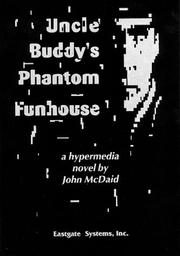He attended the Clarion workshop in 1993, and sold his first short story, the Sturgeon Award-winning “Jigoku no mokushiroku” to Asimov’s in 1995. A novelette, “Keyboard Practice,” appeared in the January, 2005 Fantasy & Science Fiction, and his most recent story, “Umbrella Men,” was the cover story in that magazine in January, 2012.
As a citizen journalist, he has written about local news and politics on his site, harddeadlines.com for the past seven years; his reporting has also appeared on RI Future.
He attended Syracuse University, did graduate work at the New School University, and is ABD in Media Ecology at NYU. He lives in Portsmouth with his wife, Karen, son, Jack, and their feline companions Curiosity and Eclipse.
Uncle Buddy’s Phantom Funhouse was an attempt to use hypermedia to embed the elements of story entirely within situationally appropriate artifacts. The conceit of the fiction was that an attorney has passed into the reader’s hands the literary estate of science fiction writer Arthur “Buddy” Newkirk. At one point, I had thought about literally distributing it on a hard drive — something that would only become possible much later — but settled for a hybrid approach, with a marked-up print proof of an unpublished story and two cassettes of music accompanying the digital traces of the vanished author.
As much as possible, I tried to adhere to one of the axioms our little cabal of theorists had cooked up: “all possible endings.” While there does exist some set of actions, pegged to times, that can be encountered in the fiction, how the reader makes sense of those will vary depending on where they have come from and where they go next. There are some characters, and two of them — Art Newkirk and Emily Keane — appear to have a good deal to say. But again, how the reader makes sense of their embedded narratives (and the degree to which they are trusted) will depend.
For me, it was important to have a balance of word and image, of discursive and presentational, and using HyperCard made that possible. To keep things loose, I added a strictly projective element, a set of “Oracle” fortune-telling cards that emerged for me as I was writing the text (and, in some cases, from which the text emerged.) And in sections of the fiction, I used the programming language, HyperTalk, as both a generator of randomness and as an embedded text.
The result, hopefully, is a text with emergent properties that could be read (and in the process, created) by a non-20th-century audience.





